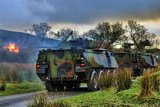DoD advances Joint Information Environment elements
The US Department of Defense (DoD) has made advancements on elements of its Joint Information Environment, it announced on 24 March.
The new elements developed by the DoD include a Joint Regional Security Stack (JRSS) and a mobility programme for smartphones. While the DoD is working on all the elements for the Joint Information Environment framework, the JRSS is a key priority according to Terry Halvorsen, chief information officer, DoD.
Halvorsen said: 'What JRSS will do when we have it right is enable a central view of all of the data that is more commonly shared by all the levels where we want to share it, which is a lot.'
The JRSS is a series of 19-inch racks in cabinets, with the racks containing network applications and appliances. Dave Cotton, lead, JRSS programme, said that this technology enables a consolidated view of the network activity and potential anomalies.
Cotton said that the JRSS will give military and defence command centre a better picture for examining analytics and taking immediate action.
As for the mobility programme, Halvorsen said that progress is being made on dual-persona unclassified Blackberry smartphones currently in use, and a modified commercial Android phone that DoD personnel can use to do secret-level security work.
Halvorsen said: 'I have ongoing mobility pilots and … I've got to be able to protect different levels of data.
'I need all data to be somewhat mobile and today I've got pretty good answers [about] how I can make unclassified data mobile.'
He also said: 'We've got some new classified devices coming out and I am very happy with where they are.
'I am a little anxious about how many of them we can field on what timeline, and we’re having some very good discussions with DISA about that.'
On the unclassified side, the DoD has started fielding the dual-persona phones, which can be used by department personnel for official business and for personal e-mail and some applications. Around 1,500 phones have been distributed so far, including the ones that were in the pilot.
More from Digital Battlespace
-
![Babcock nears first customer for Nomad AI translation tool]()
Babcock nears first customer for Nomad AI translation tool
Nomad can provide militaries with real-time intelligence, saving critical time on the battlefield.
-
![AUSA 2025: Israel’s Asio Technologies to supply hundreds of improved Taurus tactical systems]()
AUSA 2025: Israel’s Asio Technologies to supply hundreds of improved Taurus tactical systems
Taurus operates alongside the Israel Defense Forces’ Orion system which supports mission management across tens of thousands of manoeuvring forces, from squad leaders to battalion commanders.
-
![AUSA 2025: Kopin pushes micro-LED plans as China moves faster]()
AUSA 2025: Kopin pushes micro-LED plans as China moves faster
The plan for the new displays follows fresh investment in Kopin’s European facilities by Theon and an order for head-up displays in fielded aircraft, with funding from the US Department of Defense.
-
![AUSA 2025: Persistent Systems to complete its largest order by year’s end]()
AUSA 2025: Persistent Systems to complete its largest order by year’s end
Persistent Systems received its largest ever single order for its MPU5 devices and other systems earlier this month and has already delivered the 50 units to the US Army’s 4th Infantry Division.
-
![Aselsan brings in dozens of companies and systems under the Steel Dome umbrella]()
Aselsan brings in dozens of companies and systems under the Steel Dome umbrella
Turkey has joined the family of countries attempting to establish a multilayered air defence system with government approval in August 2024 for the effort landed by Aselsan. Dubbed Steel Dome, the programme joins Israel’s Iron Dome, the US Golden Dome, India’s Mission Sudarshan Chakra and South Korea’s low-altitude missile defence system.
-
![DSEI 2025: MARSS unveils new agnostic multidomain C4 system]()
DSEI 2025: MARSS unveils new agnostic multidomain C4 system
MARSS’ NiDAR system has been deployed using sensors from static platforms to provide detection and protection for static sights, such as critical infrastructure, ports and military bases.




























